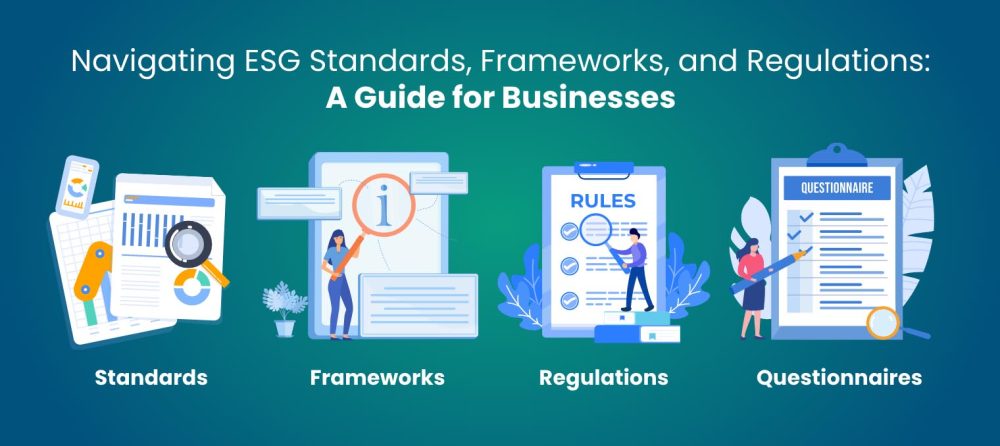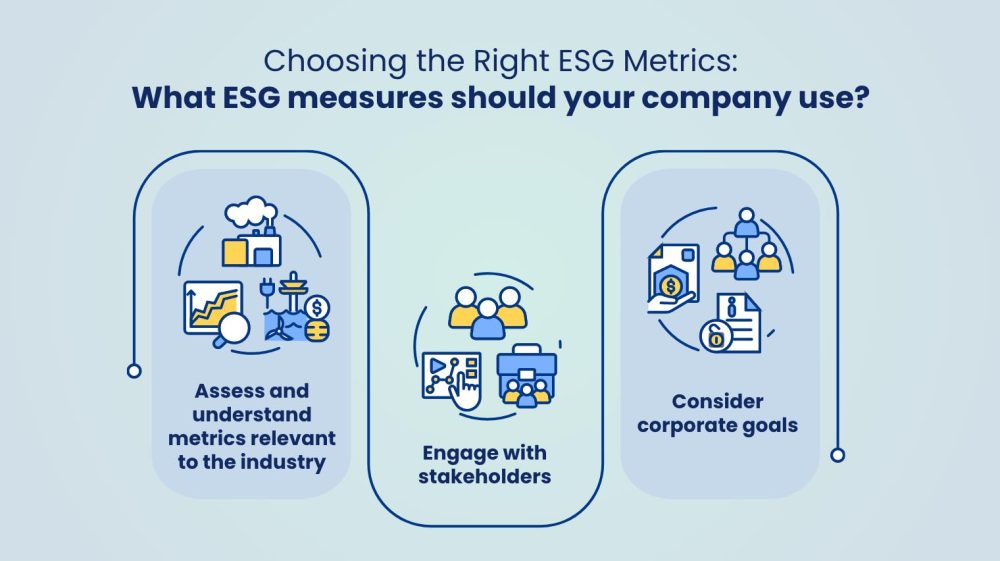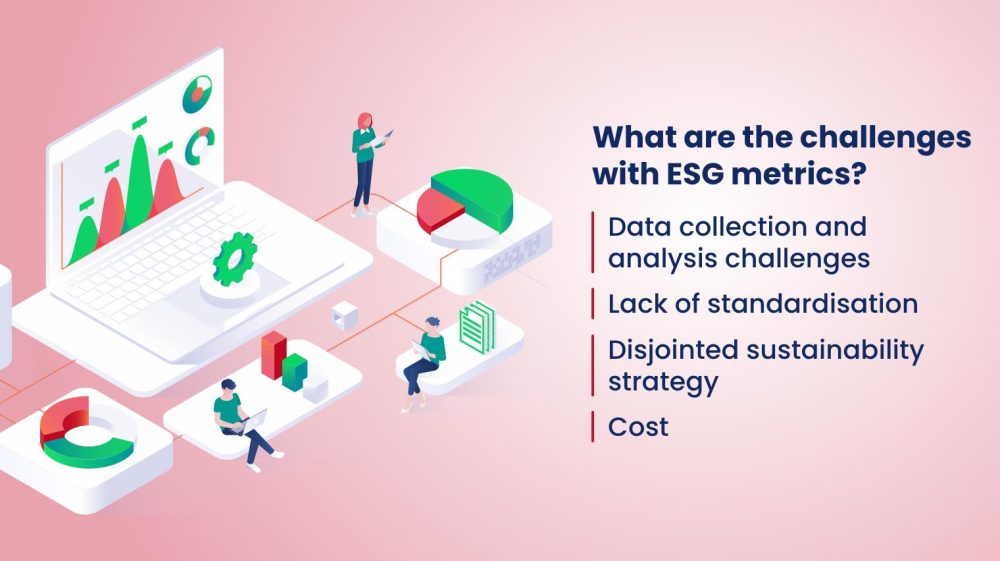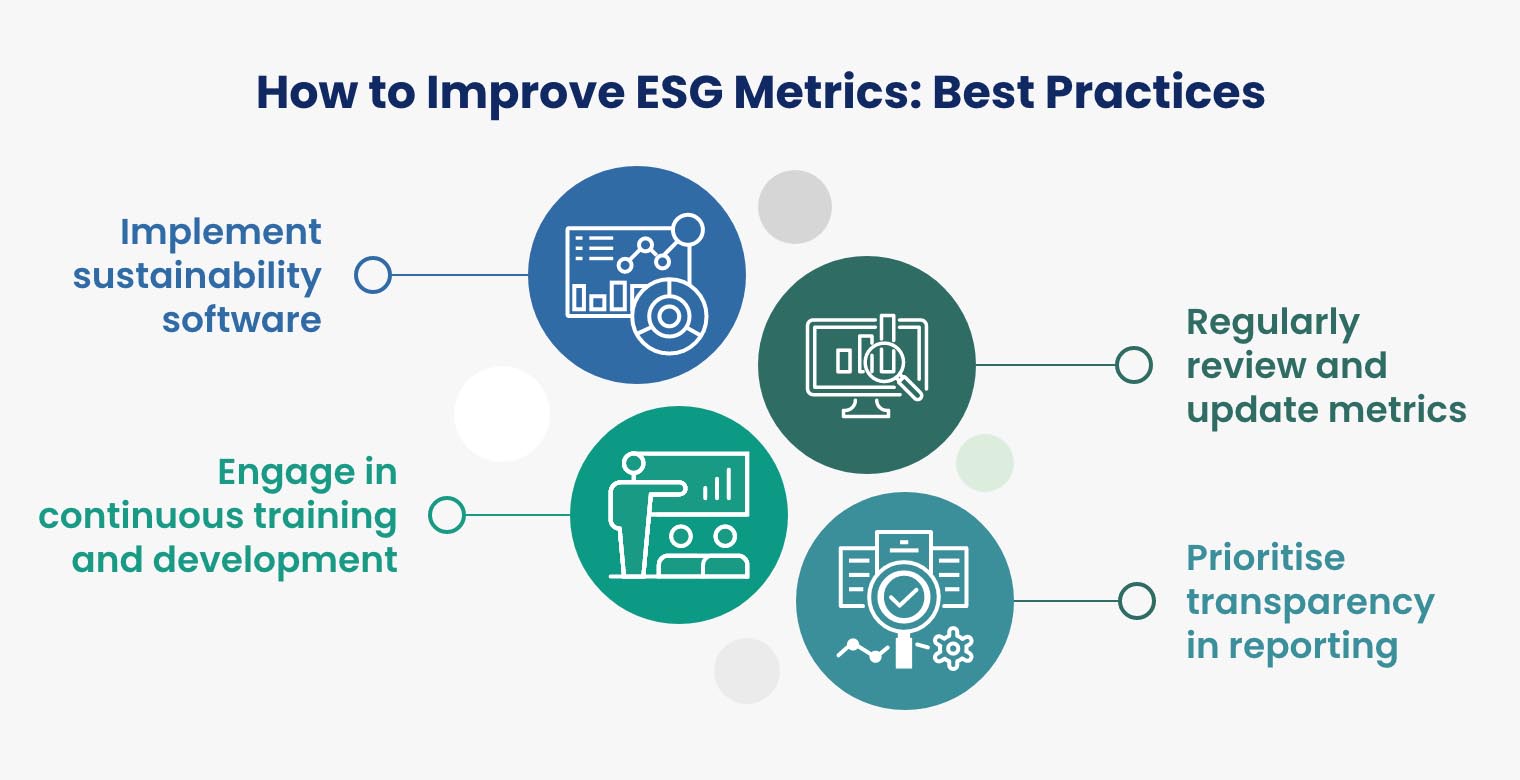Sustainability has become a priority for businesses across different sectors in the last few years as the pressure increases from investors, consumers, and regulatory bodies. Products marketed as sustainable have seen growth two times faster than those not marketed as sustainable. Likewise, 70% of individual investors believe strong sustainability practices predict higher financial returns.
With statistics leaning favourably towards prioritising positive social and/or environmental impact, companies are expected to show their commitment to sustainability to attract investment, build consumer trust, and maintain compliance.
Meeting these expectations often requires compliance to rigorous standards, which is where ESG, or Environmental, Social, and Governance, metrics are particularly useful. This article discusses the definition and significance of ESG metrics, the frameworks that support them, and how businesses can effectively incorporate these measures into their operations.
What are ESG Metrics?
Metrics are measures used to track progress. They can be qualitative or quantitative depending on the criteria being evaluated. When talking about sustainability, ESG metrics evaluate an operation’s performance on three critical factors: environmental, social, and governance issues.
ESG metrics provide a structured framework that is used as a guide for compliance with legal and regulatory requirements, ensuring that a company follows the rules set by governments or global standards. It also serves as tangible evidence of a company’s commitment to sustainability and good governance. This offers potential investors a clear insight into how seriously a company takes its ESG responsibilities.
Beyond compliance and stakeholder interest, these indicators function as a valuable benchmarking tool for organisations, enabling them to measure the effectiveness of their sustainability initiatives over time.
Why are ESG metrics important?
Primarily, ESG metrics allow companies to have a clear view of the strengths and weaknesses of their corporate sustainability efforts. Tracking the progress against ESG goals and strategies reduces risks, fosters accountability and agility, and improves investment opportunities in multiple ways.
Over the last few years, governing bodies have grown stricter with their sustainability criteria, imposing warnings and penalties on organisations that fail to keep up with ever-changing requirements.
ESG metrics provide companies with tangible data to substantiate their reporting. It keeps track of the numbers that show progress, or lack thereof, with certainty. These metrics allow organisations to maintain transparency with their key stakeholders; fostering credibility, building trust, and avoiding penalties for non-compliance.
Standards, Frameworks, and Regulations: How do they differ in ESG?
ESG reporting and ESG metrics are shaped by a variety of standards, frameworks, and regulations. Each plays a distinct role in contributing to sustainability reporting and management.

- Standards are detailed criteria that outline specific key performance measures. Its main focus is providing transparency to the general public. It requires detailed disclosure criteria, outlining specific performance measures or metrics. They focus on public interest and require rigorous governance practices. Examples include the Global Reporting Initiative (GRI) and the Sustainability Accounting Standards Board (SASB), which provide actionable guidelines for companies.
- Frameworks provide a high-level context and guiding information without specifying particular metrics. They offer best practices and suggestions on implementation. The Task Force on Climate-related Financial Disclosures (TCFD) serves as a prime example of an ESG framework.
- Regulations are mandatory sets of rules or guidelines enforced by regulatory authorities to govern ESG practices. The Corporate Sustainability Reporting Directive (CSRD) in the European Union is a key regulation aimed at increasing transparency and accountability in corporate sustainability reporting. ASEAN countries like Singapore, Malaysia, and the Philippines also have authorities fronting ESG reporting regulations.
- Additionally, Questionnaires are assessments administered by third parties, designed to evaluate sustainability performance through ESG ratings or scores. They are voluntary, and while these assessments can provide valuable insights, their methodologies tend to be less transparent and accessible compared to standards or frameworks.
While distinct differences exist between these terms, it’s essential to recognise that the ESG landscape is still relatively new. Currently, measures often vary and frequently overlap.
The trend, however, is moving toward convergence, where the most effective elements of various frameworks, regulations, and standards are merged to create common, global ESG metrics. This alignment aims to enhance consistency and comparability in ESG reporting, ultimately driving better sustainability practices across industries.
Quantitative vs. Qualitative ESG Metrics: Understanding the Differences
ESG metrics can be categorised into two main types: quantitative and qualitative.
Quantitative ESG Metrics
Quantitative ESG indicators are numerical data points that provide measurable insights into a company’s performance. Measuring greenhouse gas emissions is a great example of a quantitative metric. By categorising emissions into three groups, Scope 1, Scope 2, and Scope 3, this indicator captures the direct and indirect emissions associated with a company’s operations; helping them understand their carbon footprint. GHG Protocols enable companies to transparently report their emissions and make comparisons across sectors.
Employer turnover indicates the percentage of employees who leave an organisation over a specific timeframe. A high turnover rate may signal concerning issues with workplace culture or employee satisfaction. Companies often compare their turnover rates to industry benchmarks to assess their performance in talent retention and employee engagement.
Another significant quantitative metric is energy consumption, which measures the total energy used by a company, often expressed in kilowatt-hours (kWh). This data helps organisations identify areas for improvement in energy efficiency.
Qualitative ESG Metrics
On the other hand, qualitative ESG metrics focus on descriptive data reflecting a company’s culture and priorities. While they are subjective and more difficult to interpret, they provide valuable context for understanding a company’s commitment to its ESG efforts.
Employee satisfaction provides employees the platform to provide their feedback without fear of retaliation and consequences. Through this qualitative approach, companies can gain insight into their overall satisfaction and their suggestions for improvement.
Community engagement initiatives can also be evaluated qualitatively by examining the company’s involvement in local projects, employee volunteer hours, or partnerships with non-profit organisations. This helps illustrate the company’s commitment to social responsibility and community development.
In terms of governance, the impact of board diversity is often measured through qualitative means. Surveys and interviews shed light on perspectives involving inclusiveness, respect, trust, and collaboration as well as their effectiveness in governance and oversight.
Conducting surveys or interviews with board members to gather their perspectives on diversity. Questions can focus on how diversity impacts decision-making, the inclusiveness of discussions, and the perceived value of diverse viewpoints.
A healthy combination of both quantitative and qualitative ESG data is essential for a comprehensive ESG performance review. While quantitative metrics offer concrete evidence of performance, qualitative metrics provide narratives on the efforts driving that performance. Together, they form a holistic view of a company’s ESG governance metrics and ESG data in practice.
Key ESG Metrics: What Topics Do ESG Measures Cover?
Key ESG metrics cover a wide array of topics that companies measure to track their environmental impact, social responsibility, and governance practices. These indicators are designed to provide stakeholders with a comprehensive view across critical areas.
Here are a few examples:
Environmental Impact
Environmental metrics evaluate how a company interacts with the natural environment. Common ESG measures in this category include:
- Carbon Emissions: This metric tracks total greenhouse gas emissions, typically expressed in metric tons of CO2 equivalent. Frameworks like the TCFD emphasise the importance of disclosing emissions data.
- Energy Consumption: Companies report total energy usage, as well as the percentage derived from renewable sources. The GRI encourages transparency in energy consumption, promoting the use of renewable energy to reduce overall environmental impact.
- Water Usage and Waste Management: Metrics include total water withdrawal, discharge quality, and waste recycling rates. Reporting standards like ISO 14001 provide guidelines for environmental management systems, helping companies track and manage water and waste effectively.
Labour Practices
Labour practices focus on how companies manage their workforce and ensure employee well-being. Key ESG reporting metrics include:
- Employee Turnover Rates: This measures the rate at which employees leave the company, often calculated as a percentage of the total workforce. High turnover can signal underlying issues within the organisational culture or employee satisfaction.
- Health and Safety Incidents: Companies track the number of workplace injuries and illnesses, a crucial metric for assessing employee safety. The Occupational Safety and Health Administration (OSHA) provides guidelines for reporting workplace incidents, ensuring organisations maintain safe working environments.
- Diversity in Hiring and Promotion: Companies often report on gender, racial, and ethnic diversity within their workforce and leadership positions. Metrics may include the percentage of women in management roles, reflecting a commitment to equitable labour practices, aligned with frameworks like the SASB.
Diversity and Inclusion
Diversity and inclusion metrics assess how well a company fosters an inclusive workplace. Important ESG measures in this area include:
- Workforce Diversity Statistics: Companies report demographic data regarding their employees, such as gender, race, and ethnicity. This data provides insight into organisational diversity and inclusion initiatives.
- Inclusion Training Programs: Metrics include the percentage of employees who have undergone diversity and inclusion training. Organisations can assess the effectiveness of these programs through employee feedback and engagement surveys.
- Employee Satisfaction Surveys: Regular surveys can gauge the workplace culture and employees’ sense of belonging. Metrics from these surveys help companies identify areas for improvement and inform their diversity strategies.
Corporate Governance
Corporate governance metrics evaluate the structures and practices guiding a company’s decision-making processes. Key ESG reporting metrics in this category include:
- Board Diversity: This metric measures the composition of the board of directors, focusing on gender and racial diversity. Organisations may disclose the percentage of female directors or members from underrepresented groups. Frameworks like the International Integrated Reporting Council (IIRC) encourage transparency in governance structures.
- Executive Compensation: Companies report on the alignment of executive pay with long-term performance, including incentives tied to ESG performance metrics. The SASB provides industry-specific guidance on how to disclose executive compensation related to ESG goals.
- Compliance with Ethical Standards: Metrics may include the number of reported ethical breaches and the existence of whistleblower protection policies. Robust governance structures, guided by frameworks such as ISO 37001 (Anti-Bribery Management Systems), enhance ethical compliance and accountability.
These examples represent just a selection of the many possible ESG measures that organisations can utilise. Employing a comprehensive set of ESG reporting metrics aligned with established frameworks allows companies to provide stakeholders with valuable insights into their commitment to sustainability, social responsibility, and effective governance.
Choosing the Right ESG Metrics: What ESG measures should your company use?

Selecting the appropriate ESG metrics is crucial for organisations aiming to effectively track their sustainability initiatives and communicate their performance to stakeholders:
- Assess and understand metrics relevant to the industry. Not all indicators are applicable to all companies across the board. For instance, a manufacturing firm may prioritise environmental metrics related to emissions and resource consumption over data privacy and cybersecurity. Likewise, hospitals best focus on waste management and employee health and safety rather than energy management.
- Engage with stakeholders. Understanding the interests and concerns of investors, customers, and employees can guide the selection of ESG measures that resonate with your key stakeholders.
- Consider corporate goals. Whether your company is aiming to improve environmental performance, enhance workforce diversity, or strengthen governance practices, these objectives should serve as a guide that influences the specific metrics chosen.
What are the challenges with ESG metrics?
Despite the growing emphasis on ESG measurement, companies often encounter several challenges that can hinder effective reporting. Common obstacles include:

- Data collection and analysis challenges: Many organisations struggle with data that is stored across departments, making it difficult to gather and analyse ESG information. This fragmentation can obscure the overall environmental impact and complicate KPI establishment. A unified approach to ESG metrics is essential for effective environmental action.
- Lack of standardisation: Standardisation in ESG reporting is still very much evolving. At the moment, there is a lack of universally accepted ESG metrics and verification methods. This complicates data comparison across different industries and frameworks. International companies also face the struggle of complying with varying, often inconsistent, frameworks from a multitude of governing bodies across the globe.
- Disjointed sustainability strategy: Without a cohesive sustainability strategy, companies risk overlooking valuable opportunities for improvement. This disconnection can create operational inefficiencies, where efforts in one department fail to align with overall sustainability goals.
- Cost: Gathering quality ESG data requires resources, which can be particularly challenging for smaller businesses. Many regulations offer phased reporting mandates, but companies still need to invest in training and advanced software solutions to enhance data quality.
How to Improve ESG Metrics: Best Practices

Improving ESG metrics entails strategic implementation of both governance and operational processes. Organisations can adopt the following best practices to enhance their ESG performance:
- Implement sustainability software: Utilising ESG reporting software can streamline data collection and analysis by automating the data collection process. These tools ensure that information is up to industry standards, with minimal inconsistencies, providing reliable insights for performance monitoring and allowing organisations to make informed decisions quickly.
- Regularly review and update metrics: Continuously assess and refine ESG metrics based on stakeholder feedback and emerging trends. This ensures that metrics remain relevant and aligned with corporate goals.
- Prioritise transparency in reporting: Provide stakeholders with comprehensive and understandable information about ESG performance. This builds trust and fosters accountability, essential components of effective ESG communication.
- Engage in continuous training and development: Invest in training programs for employees that focus on ESG principles and reporting practices. This will enhance internal expertise and promote a culture of sustainability throughout the organisation.
Kickstart Accurate Data Reporting with Convene ESG

As ESG regulations continue to evolve, accurate measurement and performance tracking are becoming even more critical for businesses to maintain compliance and meet stakeholder expectations.
As such, Convene ESG emerges as an undeniably vital tool that can streamline the process of collecting and analysing ESG metrics.
Using automated data collection and calibration, Convene ESG ensures consistency and reduces the risk of errors in ESG metrics. The platform provides real-time performance tracking, enabling organisations to monitor their progress against established targets effectively. Its customisable dashboards allow users to visualise key ESG indicators at a glance, making it easier to communicate sustainability efforts to stakeholders.
With seamless integration capabilities, Convene ESG also allows organisations to consolidate data from various sources, simplifying compliance with evolving regulations. By leveraging ESG software, companies can enhance their sustainability practices and navigate the complexities of reporting standards more effectively.
Request a demo today to discover how Convene ESG’s sustainability software solutions can elevate your ESG initiatives.














